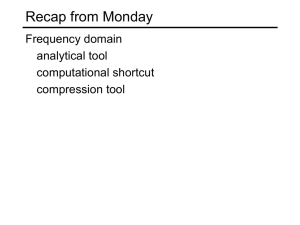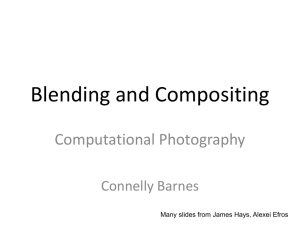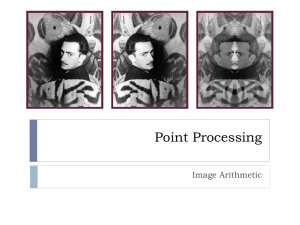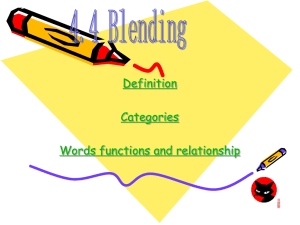ppt
advertisement
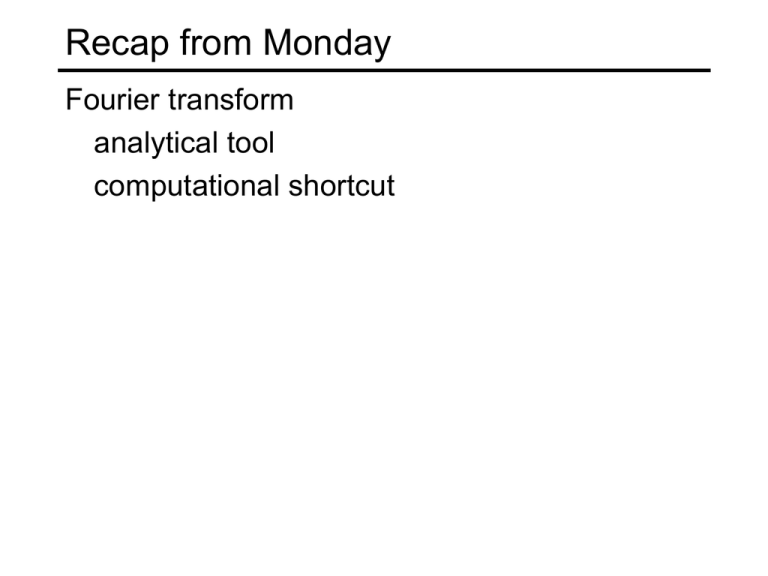
Recap from Monday Fourier transform analytical tool computational shortcut Fourier Transform in 2d in Matlab, check out: imagesc(log(abs(fftshift(fft2(im))))); Image Blending © NASA Many slides from Alexei Efros cs195g: Computational Photography James Hays, Brown, Fall 2008 Image Compositing Compositing Procedure 1. Extract Sprites (e.g using Intelligent Scissors in Photoshop) 2. Blend them into the composite (in the right order) Composite by David Dewey Need blending Alpha Blending / Feathering + 1 0 1 0 Iblend = aIleft + (1-a)Iright = Setting alpha: simple averaging Alpha = .5 in overlap region Setting alpha: center seam Distance Transform bwdist Alpha = logical(dtrans1>dtrans2) Setting alpha: blurred seam Distance transform Alpha = blurred Setting alpha: center weighting Distance transform Ghost! Alpha = dtrans1 / (dtrans1+dtrans2) Affect of Window Size 1 left 1 right 0 0 Affect of Window Size 1 1 0 0 Good Window Size 1 0 “Optimal” Window: smooth but not ghosted What is the Optimal Window? To avoid seams • window = size of largest prominent feature To avoid ghosting • window <= 2*size of smallest prominent feature Natural to cast this in the Fourier domain • largest frequency <= 2*size of smallest frequency • image frequency content should occupy one “octave” (power of two) FFT What if the Frequency Spread is Wide FFT Idea (Burt and Adelson) • Compute Fleft = FFT(Ileft), Fright = FFT(Iright) • Decompose Fourier image into octaves (bands) – Fleft = Fleft1 + Fleft2 + … • Feather corresponding octaves Flefti with Frighti – Can compute inverse FFT and feather in spatial domain • Sum feathered octave images in frequency domain Better implemented in spatial domain Octaves in the Spatial Domain Lowpass Images Bandpass Images Pyramid Blending 1 0 1 0 1 0 Left pyramid blend Right pyramid Pyramid Blending laplacian level 4 laplacian level 2 laplacian level 0 left pyramid right pyramid blended pyramid Laplacian Pyramid: Blending General Approach: 1. Build Laplacian pyramids LA and LB from images A and B 2. Build a Gaussian pyramid GR from selected region R 3. Form a combined pyramid LS from LA and LB using nodes of GR as weights: • LS(i,j) = GR(I,j,)*LA(I,j) + (1-GR(I,j))*LB(I,j) 4. Collapse the LS pyramid to get the final blended image Blending Regions Horror Photo © david dmartin (Boston College) © Chris Cameron Simplification: Two-band Blending Brown & Lowe, 2003 • Only use two bands: high freq. and low freq. • Blends low freq. smoothly • Blend high freq. with no smoothing: use binary alpha 2-band Blending Low frequency (l > 2 pixels) High frequency (l < 2 pixels) Linear Blending 2-band Blending Don’t blend, CUT! Moving objects become ghosts So far we only tried to blend between two images. What about finding an optimal seam? Davis, 1998 Segment the mosaic • Single source image per segment • Avoid artifacts along boundries – Dijkstra’s algorithm Minimal error boundary overlapping blocks _ vertical boundary 2 = overlap error min. error boundary Graphcuts What if we want similar “cut-where-thingsagree” idea, but for closed regions? • Dynamic programming can’t handle loops Graph cuts (simple example à la Boykov&Jolly, ICCV’01) hard constraint t n-links a cut hard constraint s Minimum cost cut can be computed in polynomial time (max-flow/min-cut algorithms) Kwatra et al, 2003 Actually, for this example, DP will work just as well… Lazy Snapping Interactive segmentation using graphcuts Gradient Domain In Pyramid Blending, we decomposed our image into 2nd derivatives (Laplacian) and a low-res image Let us now look at 1st derivatives (gradients): • No need for low-res image – captures everything (up to a constant) • Idea: – Differentiate – Blend – Reintegrate Gradient Domain blending (1D) bright Two signals dark Regular blending Blending derivatives Gradient Domain Blending (2D) Trickier in 2D: • Take partial derivatives dx and dy (the gradient field) • Fidle around with them (smooth, blend, feather, etc) • Reintegrate – But now integral(dx) might not equal integral(dy) • Find the most agreeable solution – Equivalent to solving Poisson equation – Can use FFT, deconvolution, multigrid solvers, etc. Perez et al., 2003 Perez et al, 2003 editing Limitations: • Can’t do contrast reversal (gray on black -> gray on white) • Colored backgrounds “bleed through” • Images need to be very well aligned Putting it all together Compositing images • Have a clever blending function – – – – Feathering Center-weighted blend different frequencies differently Gradient based blending • Choose the right pixels from each image – Dynamic programming – optimal seams – Graph-cuts Now, let’s put it all together: • Interactive Digital Photomontage, 2004 (video)
